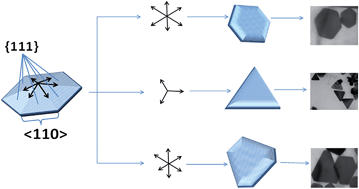Single step synthesis of pluronic stabilized IR responsive gold nanoplates
Abstract
A single-step seed-mediated synthesis is employed to produce biocompatible infrared (IR) responsive gold nanoplates (Au-NPs) by using a biocompatible tri-block copolymer, pluronic F-127. Pluronic F-127 acts as a reducing, stabilizing and shape directing agent. Its hydrophobic polypropylene oxide (PPO) unit, preferentially binds to the {111} planes of FCC Au nuclei, inhibiting the growth on {111} crystallographic planes and promotes anisotropic growth along the {110} facets. Well faceted hexagonal, triangular and truncated triangular plates are obtained whose size ranges from 46 nm to 108 nm. These gold nanoplates exhibit strong surface plasmon resonance corresponding to in-plane quadruple vibrations which are tunable from 810 nm to 900 nm in the near-infrared (NIR) region. Aging effect of gold nanoplates are also monitored in terms of their plasmonic properties over a period of several weeks as synthesized nanoplates when preserved in pluronic F-127 demonstrate impressive stability over a period of several weeks. Tunable absorption of biocompatible gold nanoplates in the NIR region opens up new possibilities in the field of cancer diagnostics and therapeutics. The aging effect on the plasmon bands of Au-NPs is also monitored for several weeks when preserved in pluronic solvent.


 Please wait while we load your content...
Please wait while we load your content...